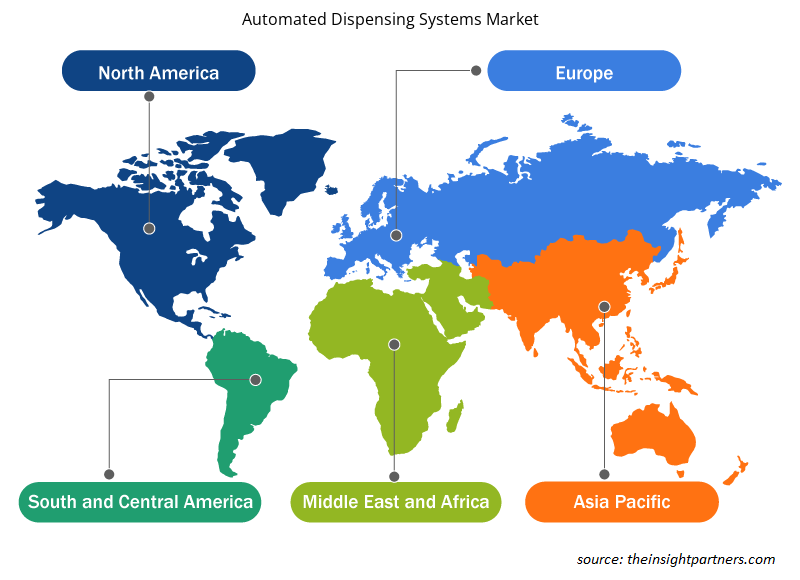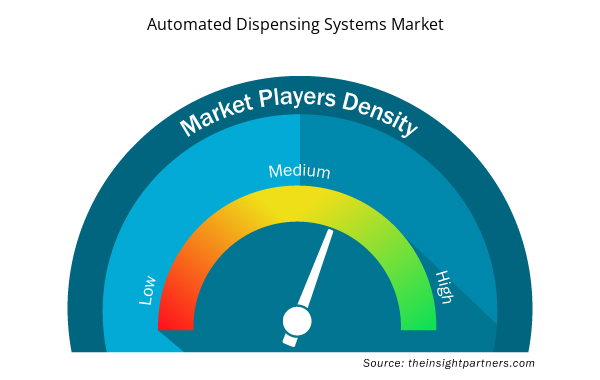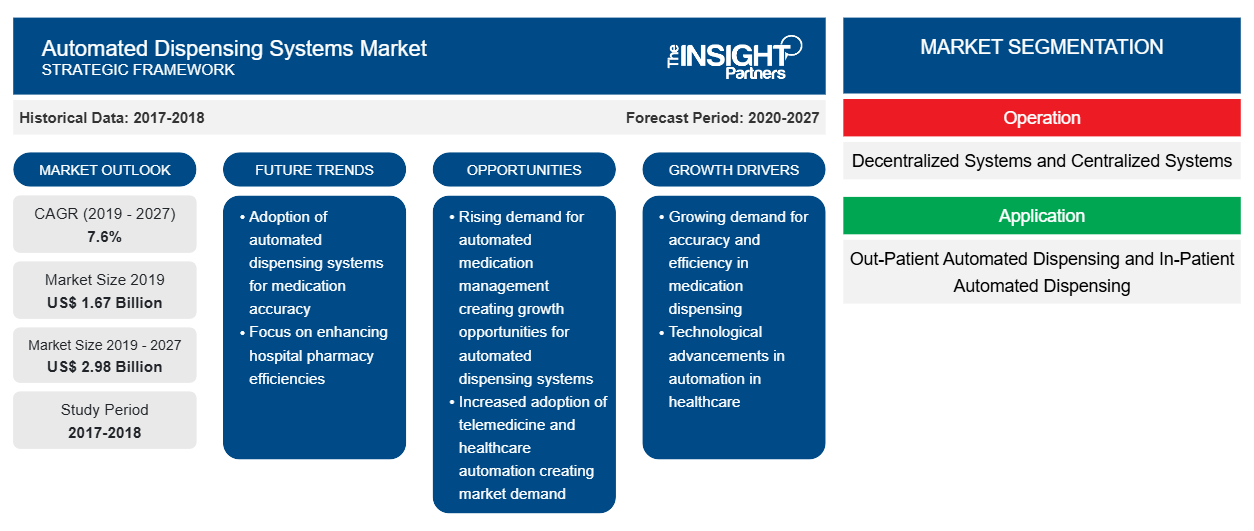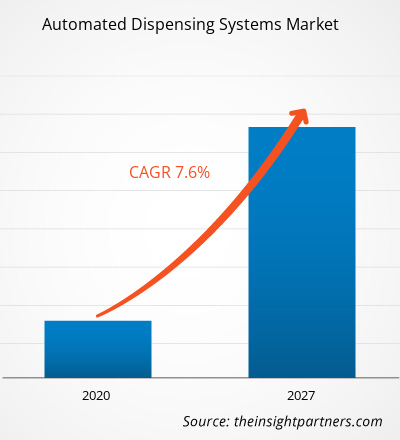Le marché des systèmes de distribution automatisés devrait atteindre 2 980,38 millions USD d'ici 2027, contre 1 665,78 millions USD en 2019 ; il devrait croître à un TCAC de 7,6 % au cours de la période 2020-2027.
Les systèmes de distribution automatisés, également appelés armoires à médicaments automatisées, sont des dispositifs électroniques de stockage et de distribution de médicaments, principalement utilisés dans les établissements de santé. Ces systèmes aident à suivre et à contrôler la distribution des médicaments ; ils sont sécurisés par des mots de passe authentifiés et des données biométriques pour le contrôle des stocks et la sécurité des médicaments contre les vols. Ces systèmes ont été mis en avant comme l'un des instruments potentiels pour améliorer l'efficacité opérationnelle et la sécurité des patients. De plus, ils sont désormais largement utilisés dans les cliniques et les maisons de retraite, entre autres. Les systèmes de distribution automatisés contribuent à transformer les hôpitaux en institutions plus sûres, plus efficaces et plus efficientes.
Le marché mondial des systèmes de distribution automatisés est influencé par des facteurs tels que l'augmentation des erreurs de médication et la croissance de la population gériatrique. Cependant, les problèmes associés aux systèmes de distribution automatisés, tels que les erreurs de saisie de programme, les pannes d'équipement et autres, peuvent entraver la croissance du marché. De plus, les marchés émergents créent des opportunités de croissance pour les acteurs du marché.
Personnalisez ce rapport en fonction de vos besoins
Vous bénéficierez d'une personnalisation gratuite de n'importe quel rapport, y compris de certaines parties de ce rapport, d'une analyse au niveau des pays, d'un pack de données Excel, ainsi que d'offres et de remises exceptionnelles pour les start-ups et les universités.
- Obtenez les principales tendances clés du marché de ce rapport.Cet échantillon GRATUIT comprendra une analyse de données, allant des tendances du marché aux estimations et prévisions.
Informations sur le marché
Augmentation des erreurs de médication
Une distribution irrationnelle, inappropriée et inefficace de médicaments peut entraîner de graves erreurs de médication qui peuvent nuire aux patients. Parmi les erreurs de médication les plus courantes, on trouve la distribution d'un médicament incorrect, la distribution d'une quantité incorrecte de médicament, la distribution d'un médicament de dosage incorrect et l'omission d'un article. Environ 75 % des erreurs de médication sont causées par des distractions, car les professionnels de la santé sont occupés à de multiples tâches telles que l'examen des patients, les discussions avec les consultants, les discussions avec les membres de la famille des patients, les conversations avec les professionnels de l'assurance.
Chaque année, la Food and Drug Administration (FDA) des États-Unis reçoit plus de 100 000 signalements liés à des erreurs de médication. De plus, selon l’étude « Medication Errors » publiée dans StatPearls en juin 2020, chaque année, environ 7 000 à 9 000 personnes meurent à cause d’une erreur de médication aux États-Unis. De même, selon les estimations publiées dans l’étude « Prevalence and Economic Burden of Medication Errors in the NHS In England » en 2018, chaque année, environ 237 millions d’erreurs de médication se produisent dans le NHS et les effets indésirables évitables des médicaments (EIM) entraînent des centaines de décès.
Informations basées sur les opérations
En fonction de leur fonctionnement, le marché des systèmes de distribution automatisés est segmenté en systèmes décentralisés et systèmes centralisés. Le segment des systèmes centralisés détenait une part de marché plus importante en 2019 en raison de facteurs tels que le besoin croissant de réduire les coûts, d'assurer la disponibilité des médicaments et de moderniser l'allocation des ressources. De plus, les systèmes décentralisés devraient enregistrer un TCAC plus élevé sur le marché au cours de la période de prévision.
Informations basées sur les applications
En fonction des applications, le marché des systèmes de distribution automatisés est segmenté en distribution automatisée pour patients hospitalisés et en distribution automatisée pour patients ambulatoires. Le segment de la distribution automatisée pour patients hospitalisés détenait une part de marché plus importante en 2019 ; cependant, la distribution automatisée pour patients ambulatoires devrait enregistrer un TCAC plus élevé au cours de la période de prévision.
Informations basées sur l'utilisateur final
En fonction de l'utilisateur final, le marché des systèmes de distribution automatisés est segmenté en pharmacies hospitalières, pharmacies de détail et autres. Le segment des pharmacies hospitalières détenait la plus grande part du marché en 2019 ; cependant, le segment des pharmacies de détail devrait enregistrer le TCAC le plus élevé du marché au cours de la période de prévision.
Les lancements et les approbations de produits sont les stratégies couramment adoptées par les entreprises pour étendre leur présence mondiale et leurs portefeuilles de produits ; ces stratégies les aident à répondre à la demande croissante des consommateurs. La collaboration est l'une des principales stratégies adoptées par les acteurs du marché des systèmes de distribution automatisés pour élargir leur clientèle dans le monde entier, ce qui leur permet également de maintenir leur nom de marque à l'échelle mondiale.
Aperçu régional du marché des systèmes de distribution automatisés
Les tendances régionales et les facteurs influençant le marché des systèmes de distribution automatisés tout au long de la période de prévision ont été expliqués en détail par les analystes d’Insight Partners. Cette section traite également des segments et de la géographie du marché des systèmes de distribution automatisés en Amérique du Nord, en Europe, en Asie-Pacifique, au Moyen-Orient et en Afrique, ainsi qu’en Amérique du Sud et en Amérique centrale.

- Obtenez les données régionales spécifiques au marché des systèmes de distribution automatisés
Portée du rapport sur le marché des systèmes de distribution automatisés
| Attribut de rapport | Détails |
|---|---|
| Taille du marché en 2019 | 1,67 milliard de dollars américains |
| Taille du marché d'ici 2027 | 2,98 milliards de dollars américains |
| Taux de croissance annuel composé mondial (2019-2027) | 7,6% |
| Données historiques | 2017-2018 |
| Période de prévision | 2020-2027 |
| Segments couverts | Par opération
|
| Régions et pays couverts | Amérique du Nord
|
| Leaders du marché et profils d'entreprises clés |
|
Densité des acteurs du marché des systèmes de distribution automatisés : comprendre son impact sur la dynamique commerciale
Le marché des systèmes de distribution automatisés connaît une croissance rapide, tirée par la demande croissante des utilisateurs finaux en raison de facteurs tels que l'évolution des préférences des consommateurs, les avancées technologiques et une plus grande sensibilisation aux avantages du produit. À mesure que la demande augmente, les entreprises élargissent leurs offres, innovent pour répondre aux besoins des consommateurs et capitalisent sur les tendances émergentes, ce qui alimente davantage la croissance du marché.
La densité des acteurs du marché fait référence à la répartition des entreprises ou des sociétés opérant sur un marché ou un secteur particulier. Elle indique le nombre de concurrents (acteurs du marché) présents sur un marché donné par rapport à sa taille ou à sa valeur marchande totale.
Les principales entreprises opérant sur le marché des systèmes de distribution automatisés sont :
- AbbVie Inc.
- Abbott
- F. Hoffmann-La Roche SARL
- Société Bristol-Myers Squibb
- Johnson & Johnson Services, Inc.
Avis de non-responsabilité : les sociétés répertoriées ci-dessus ne sont pas classées dans un ordre particulier.

- Obtenez un aperçu des principaux acteurs du marché des systèmes de distribution automatisés
Marché mondial des systèmes de distribution automatisés – par opération
- Systèmes décentralisés
- Systèmes centralisés
Marché mondial des systèmes de distribution automatisés – par application
- Distribution automatique de médicaments en consultation externe
- Distribution automatisée de médicaments aux patients hospitalisés
Marché mondial des systèmes de distribution automatisés – par utilisateur final
- Pharmacies de détail
- Pharmacies hospitalières
- Autres
Marché des systèmes de distribution automatisés – par géographie
Amérique du Nord
- NOUS
- Canada
- Mexique
Europe
- France
- Allemagne
- Italie
- ROYAUME-UNI
- Espagne
- Reste de l'Europe
Asie-Pacifique (APAC)
- Chine
- Inde
- Corée du Sud
- Japon
- Australie
- Reste de l'Asie-Pacifique
Moyen-Orient et Afrique (MEA)
- Afrique du Sud
- Arabie Saoudite
- Émirats arabes unis
- Reste du Moyen-Orient et de l'Afrique
Amérique du Sud et Amérique centrale
- Brésil
- Argentine
- Reste de l'Amérique du Sud
Profils d'entreprise
- Société Cerner
- Capsa Santé
- Omnicell, Inc
- BD
- ARxIUM
- Systèmes de soins de santé Accu-Chart Plus, Inc.
- Associés en innovation
- Systèmes RxMedic, Inc.
- Swiss Log Holding SA
- Willach Pharmacy Solutions GmbH
- Analyse historique (2 ans), année de base, prévision (7 ans) avec TCAC
- Analyse PEST et SWO
- Taille du marché Valeur / Volume - Mondial, Régional, Pays
- Industrie et paysage concurrentiel
- Ensemble de données Excel



Report Coverage
Revenue forecast, Company Analysis, Industry landscape, Growth factors, and Trends

Segment Covered
This text is related
to segments covered.

Regional Scope
North America, Europe, Asia Pacific, Middle East & Africa, South & Central America

Country Scope
This text is related
to country scope.
Questions fréquemment posées
The anti-viral therapiesmarket majorly consists of the players such as Cerner Corporation, Capsa Healthcare, Omnicell, Inc, BD, ARxIUM, Accu-Chart Plus Healthcare Systems, Inc, Innovation Associates, RxMedic Systems, Inc, Swiss log Holding Ltd and Willach Pharmacy Solutions GmbHamongst others.
The factors that are driving growth of the market are increasing medication errors, increasing prevalence of chronic diseases and rising geriatric population. Moreover, emerging markets is expected to offer lucrative opportunities for the growth of the market.
Automated dispensing system, also termed as automated drug cabinet, is an electronic drug storage and dispensing device primarily used in health care settings. These systems aid in tracking and controlling the drug distribution and are secured with authenticated passwords and biometrics for inventory control and security of the drugs. These systems have been recommended as one of the potential instruments to improve efficiency and patient safety, and they are now widely used in many hospitals, for instance in clinics, nursing homes. Automated dispensing system helps to transform hospitals into safer, more efficient and more effective institutions.
Trends and growth analysis reports related to Life Sciences : READ MORE..
The List of Companies - Automated Dispensing Systems Market
- AbbVie Inc.
- Abbott
- F. Hoffmann-La Roche Ltd
- Bristol-Myers Squibb Company
- Johnson & Johnson Services, Inc.
- Merck and Co., Inc.
- Gilead Sciences, Inc.
- GlaxoSmithKline plc
- Aurobindo Pharma
- AstraZeneca
The Insight Partners performs research in 4 major stages: Data Collection & Secondary Research, Primary Research, Data Analysis and Data Triangulation & Final Review.
- Data Collection and Secondary Research:
As a market research and consulting firm operating from a decade, we have published and advised several client across the globe. First step for any study will start with an assessment of currently available data and insights from existing reports. Further, historical and current market information is collected from Investor Presentations, Annual Reports, SEC Filings, etc., and other information related to company’s performance and market positioning are gathered from Paid Databases (Factiva, Hoovers, and Reuters) and various other publications available in public domain.
Several associations trade associates, technical forums, institutes, societies and organization are accessed to gain technical as well as market related insights through their publications such as research papers, blogs and press releases related to the studies are referred to get cues about the market. Further, white papers, journals, magazines, and other news articles published in last 3 years are scrutinized and analyzed to understand the current market trends.
- Primary Research:
The primarily interview analysis comprise of data obtained from industry participants interview and answers to survey questions gathered by in-house primary team.
For primary research, interviews are conducted with industry experts/CEOs/Marketing Managers/VPs/Subject Matter Experts from both demand and supply side to get a 360-degree view of the market. The primary team conducts several interviews based on the complexity of the markets to understand the various market trends and dynamics which makes research more credible and precise.
A typical research interview fulfils the following functions:
- Provides first-hand information on the market size, market trends, growth trends, competitive landscape, and outlook
- Validates and strengthens in-house secondary research findings
- Develops the analysis team’s expertise and market understanding
Primary research involves email interactions and telephone interviews for each market, category, segment, and sub-segment across geographies. The participants who typically take part in such a process include, but are not limited to:
- Industry participants: VPs, business development managers, market intelligence managers and national sales managers
- Outside experts: Valuation experts, research analysts and key opinion leaders specializing in the electronics and semiconductor industry.
Below is the breakup of our primary respondents by company, designation, and region:

Once we receive the confirmation from primary research sources or primary respondents, we finalize the base year market estimation and forecast the data as per the macroeconomic and microeconomic factors assessed during data collection.
- Data Analysis:
Once data is validated through both secondary as well as primary respondents, we finalize the market estimations by hypothesis formulation and factor analysis at regional and country level.
- Macro-Economic Factor Analysis:
We analyse macroeconomic indicators such the gross domestic product (GDP), increase in the demand for goods and services across industries, technological advancement, regional economic growth, governmental policies, the influence of COVID-19, PEST analysis, and other aspects. This analysis aids in setting benchmarks for various nations/regions and approximating market splits. Additionally, the general trend of the aforementioned components aid in determining the market's development possibilities.
- Country Level Data:
Various factors that are especially aligned to the country are taken into account to determine the market size for a certain area and country, including the presence of vendors, such as headquarters and offices, the country's GDP, demand patterns, and industry growth. To comprehend the market dynamics for the nation, a number of growth variables, inhibitors, application areas, and current market trends are researched. The aforementioned elements aid in determining the country's overall market's growth potential.
- Company Profile:
The “Table of Contents” is formulated by listing and analyzing more than 25 - 30 companies operating in the market ecosystem across geographies. However, we profile only 10 companies as a standard practice in our syndicate reports. These 10 companies comprise leading, emerging, and regional players. Nonetheless, our analysis is not restricted to the 10 listed companies, we also analyze other companies present in the market to develop a holistic view and understand the prevailing trends. The “Company Profiles” section in the report covers key facts, business description, products & services, financial information, SWOT analysis, and key developments. The financial information presented is extracted from the annual reports and official documents of the publicly listed companies. Upon collecting the information for the sections of respective companies, we verify them via various primary sources and then compile the data in respective company profiles. The company level information helps us in deriving the base number as well as in forecasting the market size.
- Developing Base Number:
Aggregation of sales statistics (2020-2022) and macro-economic factor, and other secondary and primary research insights are utilized to arrive at base number and related market shares for 2022. The data gaps are identified in this step and relevant market data is analyzed, collected from paid primary interviews or databases. On finalizing the base year market size, forecasts are developed on the basis of macro-economic, industry and market growth factors and company level analysis.
- Data Triangulation and Final Review:
The market findings and base year market size calculations are validated from supply as well as demand side. Demand side validations are based on macro-economic factor analysis and benchmarks for respective regions and countries. In case of supply side validations, revenues of major companies are estimated (in case not available) based on industry benchmark, approximate number of employees, product portfolio, and primary interviews revenues are gathered. Further revenue from target product/service segment is assessed to avoid overshooting of market statistics. In case of heavy deviations between supply and demand side values, all thes steps are repeated to achieve synchronization.
We follow an iterative model, wherein we share our research findings with Subject Matter Experts (SME’s) and Key Opinion Leaders (KOLs) until consensus view of the market is not formulated – this model negates any drastic deviation in the opinions of experts. Only validated and universally acceptable research findings are quoted in our reports.
We have important check points that we use to validate our research findings – which we call – data triangulation, where we validate the information, we generate from secondary sources with primary interviews and then we re-validate with our internal data bases and Subject matter experts. This comprehensive model enables us to deliver high quality, reliable data in shortest possible time.


 Obtenez un échantillon gratuit pour ce rapport
Obtenez un échantillon gratuit pour ce rapport